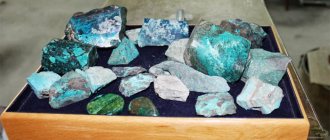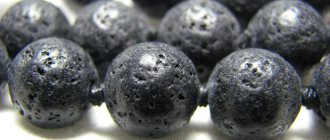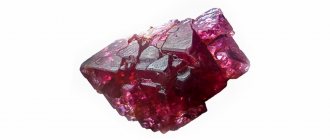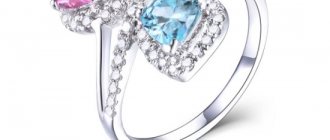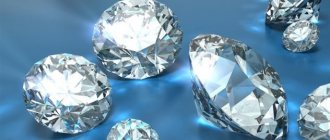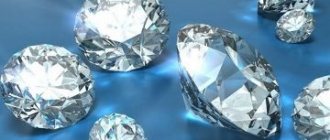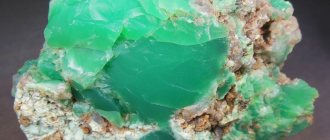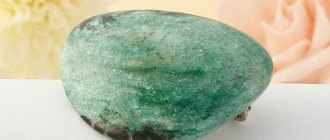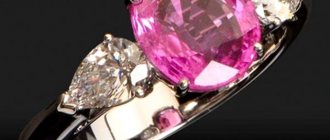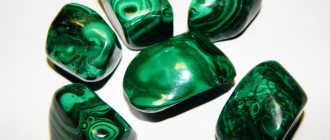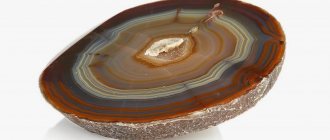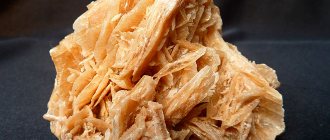- Which: Semi-precious;
- Place of Birth: -;
- Colors: Black, green, white, blue or red.;
- Mohs hardness: 7.5-8.5;
- Transparency: Transparent or translucent;
- Density: 6.5-10 g/cm3;
- Formula: Zr0.8Ca0.2O1.92;
- Suitable person according to zodiac sign: Everyone;
- How much does it cost: from 1 dollar per gram.
The limitation of natural resources has led humanity to the creation of their synthetic analogues. Scientific developments and jewelry making were not spared.
In 1968, an artificial double of the diamond was developed - the cubic zirconia stone. Its similarity to the precious standard has given rise to many fraudulent schemes, which has provoked a negative attitude towards the valuable scientific invention.
History of invention
The artificial stone owes its name to the Physical Institute of the Lebedev Academy of Sciences (FIAN), where it was created. Initially, the goal of the research was to obtain a material with certain optical properties necessary for laser equipment.
But already in the early 70s of the last century, cubic zirconia caused panic in foreign jewelry markets: a stone almost identical to a diamond cost a penny. In the 1990s alone, crystals with a total weight of 50,000,000 carats were produced worldwide. Since then, production rates have only increased.
Confusion in terminology
The term “cubic zirconia” is used only in the CIS countries and Eastern Europe.
In the global jewelry community, other names are used to describe the insert in a product:
- jewellite;
- zirconite;
- daimonsquay.
Cubic zirconia is incorrectly called zirconium. Zirconium is a metal, and only its cubic dioxide has a crystal structure.
In addition, there is zircon, a natural semi-precious stone. A mineral of igneous origin is several times more expensive than cubic zirconia.
Cubic zirconia is also often confused with Swarovski crystals, which are a proprietary type of crystal.
Where and how is stone mined?
Artificial analogues of diamond do not require activities related to their extraction. There are no deposits of this crystal, since it is obtained artificially.
Several laboratories have been opened that grow cubic zirconia in Russia, European countries and the USA. But there are also many underground workshops where it is produced, so you always need to pay scrupulous attention to the quality of the stone you are purchasing.
Appearance and color options
Cubic zirconium dioxide is colorless, but technology allows it to be given in more than 40 different shades.
Most Popular:
- yellow;
- pink;
- green;
- purple;
- brown with a golden tint.
In addition, a color changing effect is possible, allowing you to imitate rare and very expensive alexandrite. At the same time, scientists still cannot obtain cubic zirconia of emerald green color.
Production
The stones are synthesized using high-frequency melting. Process description:
- The raw material (powdered zirconium oxide) is loaded into a container.
- A high-frequency generator supplies energy that melts the inside.
- Water circulating through the tubes prevents the temperature from rising above room temperature, so the outer layer of the substance remains cold and solid.
- The melt cools to room temperature.
- Columns 2 cm high and 2 cm in diameter are removed from the solid core.
The cycle is short: crystals grow by 8–10 mm per hour.
This is Soviet technology. It was invented by scientists, whom the state did not restrict in the use of resources. It is problematic for market conditions; even countries that bought it or received it from the USSR are simplifying production. But the resulting material is not cubic zirconia.
The cheapest are translucent, colorless or transparent crystals. Colored ones are more expensive: the external resemblance to precious gems is ensured by metal oxides and the subtleties of the process. The most expensive ones are multi-colored and imitation diamonds.
Precious or not?
Cubic zirconia enchants with its excellent play of light and perfect purity. In appearance, it is in no way inferior to precious stones and is difficult to distinguish from a diamond. Cubic zirconias are widely used in jewelry and make it possible to create real masterpieces, each of which has considerable value. All this leads to the question, is cubic zirconia a gemstone or not?
Cubic zirconia is often called an artificial diamond. But its origin and low cost of production devalue the magnificent appearance of the crystal - it is not at all rare. This means that cubic zirconia cannot be a precious stone.
Creation and application process
The gem production technology created by Soviet physicists is labor-intensive and consists of several stages:
- The raw material, zirconium oxide powder, is placed in a special container.
- Under the influence of high-frequency generator energy, the internal part melts.
- Water circulates through the tubes, which regulates the temperature of the outer layer - it should not rise above room temperature. The outer layer should be hard and cool.
Next, the molten inner layer cools to room temperature, the core hardens, and cylinders measuring 2*2 cm are removed from it. The crystal growth cycle is very short - the material grows by an average of 9 mm in an hour.
Today, for most countries, Soviet technology is too expensive, which leads to simplification of production. However, stones created using a simplified method cannot be called real cubic zirconia.
Cubic zirconium is used mainly in jewelry. However, some industries also cannot do without this material. In dentistry it is ceramic coating, in optics it is lenses, in the chemical industry it is refractory mixtures. Non-jewelry quality stones are used for such needs.
How to distinguish cubic zirconia from a diamond?
The similarity of cubic zirconia with a diamond has led to it being used as a counterfeit of its precious “brother,” but there are several ways to help distinguish them:
- Crystal purity. Cubic zirconia can only imitate a diamond of very good quality, without internal cracks or defects. Precious stones of perfect purity, especially large ones, are quite rare in nature. So if you see an inexpensive crystal with absolutely no flaws, it means it is cubic zirconia.
- Quality of cut. Upon closer examination through a magnifying glass or microscope, you can notice that cubic zirconia crystals have blurred and double edges. However, if the fake is of good quality, the cutting can also be performed at the highest level.
- Dirt-repellent properties. If you drop a little oil on the surface of a diamond, it will easily flow down the surface. Imitation tends to accumulate dust, grease and dirt, which is why it loses its shine over time.
- Weight of the stone. Zirconium dioxide has a higher density than diamond. Two stones of the same size can be weighed: the one that turns out to be lighter is the diamond. True, this method is difficult to implement if the crystals are fixed in the product.
- Hardness. Diamond is the hardest of all minerals; it can cut glass, but imitation will only leave a mark on the surface. In addition, a diamond can scratch cubic zirconia, but cubic zirconia cannot scratch a diamond.
- Thermal conductivity. A natural stone can be recognized by pressing it to the cheek - the surface of the mineral almost always remains cold. More accurate identification is provided by diamond testers - devices that determine the thermal conductivity of a stone, and based on the obtained values, they can easily recognize an imitation.
Unfortunately, there are such skillful fakes that none of the above methods gives complete confidence in the authenticity of the diamond. An expert opinion and certificate for a stone can only be issued by a gemological laboratory.
The difference between cubic zirconia and diamond
Externally, cubic zirconia and processed diamond are difficult to distinguish between the average buyer. But their properties and origins are completely different.
Chemical composition
Cubic zirconia is chemically zirconium dioxide. A diamond, or cut diamond, is a cubic form of carbon.
Stone hardness
Diamond is the standard of hardness among all minerals. No other stone can scratch it. The hardness of cubic zirconia is lower ; rubies and sapphire can leave marks on it. The edges of cubic zirconia gradually wear off and become rounded due to its low strength. Some manufacturers immediately make them semicircular at the cutting stage.
Density, on the contrary, is higher in cubic zirconia. Therefore, they are heavier than diamonds , but you can only check the weight of stones without a setting.
Optical properties
Both stones are transparent, but natural diamonds have microscopic impurities and cracks in their structure. Their quantity is used to evaluate one of the quality parameters of diamonds – purity. The fewer impurities, the purer and more expensive the gemstone. Cubic zirconia is absolutely homogeneous, but less valuable .
View this post on Instagram
Pajama Post
